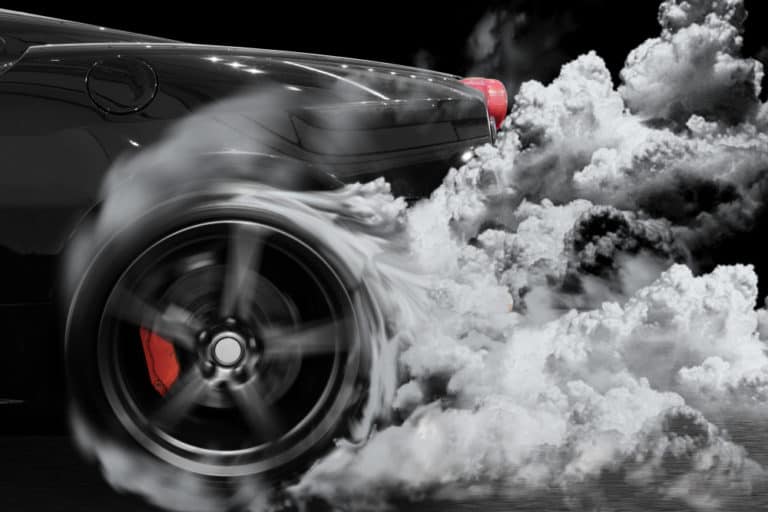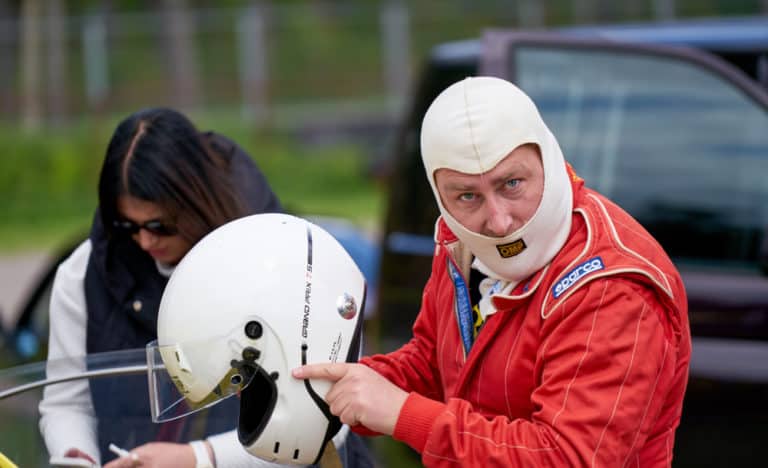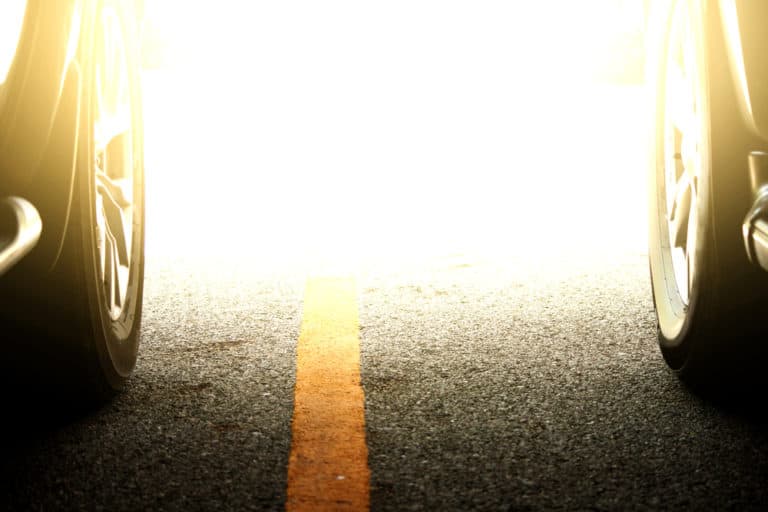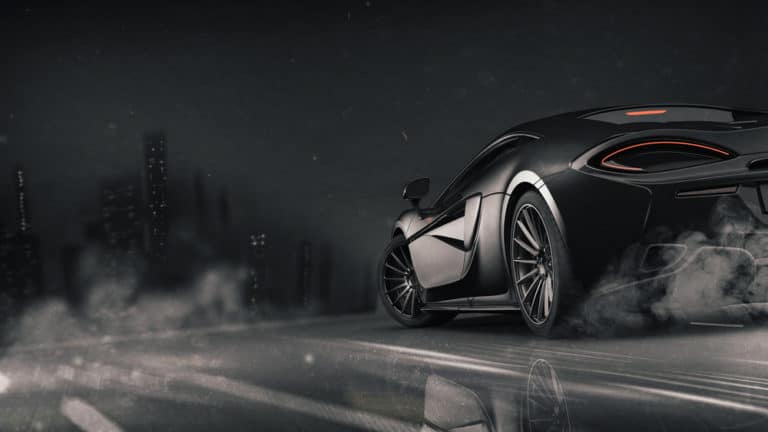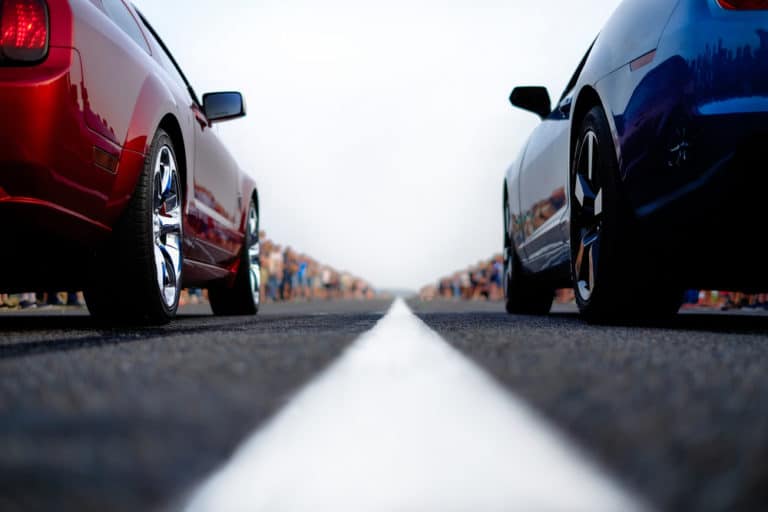Image: Shutterstock.com
Not much comes close to the exhilaration of drag racing. The speed and power are the backbones of drag racing, and whether you are a fan or racer, the love of the sport is undeniable. Drag racing is not simply getting in a car and hitting the gas; there are many preparations to be made and, of course, a whole list of rules that need to be adhered to. Before you get into a drag racing car, you need to have a complete guide on how to drag race legally.
To drag race legally, you need a valid license, a car in working order, and compliance with all traffic law requirements and NHRA safety regulations. Car insurance needs to be up to date. Personal safety equipment like helmets, cotton clothing, closed shoes, and socks must be worn during a race. Your car needs to be fitted with DOT-approved street-legal racing tires.
Although it seems like a lot of paperwork before you can hit the drag strip, these strict rules are put in place to safeguard all participants, pit crew members, and spectators. The responsible thing to do is ensure your car, paperwork, and equipment are working order and up to date. That way, you can drag race legally without recourse. Let’s look at the complete guide on how to drag race legally more in-depth.
Is It Legal To Drag Race?
Street drag racing is defined as two cars that are in a high-speed competition using a public access road or highway for that purpose. Doing this breaks several laws and is a misdemeanor in almost all states across the USA.
It is a crime due to the intentional participation in such an activity and therefore becomes an illegal act. Drag racing on public property is prohibited.
The best way to participate in street-style drag racing is to find tracks in your area that offer beginner to professional racing days. You can join the events by paying a fee and doing all relevant paperwork.
Where Can You Legally Drag Race?
Depending on your state, you can find a track that is an NHRA member. They host Street Legal Style drag races often. Here are some tracks that you can visit; check out the NHRA site for a complete guide;
- Iowa, Cedar Falls – Cedar Falls Motorsports Park.
- Arizona, Chandler – Wild Horse Pass Motorsports Park.
- California, San Diego – Qualcomm Stadium.
- Colorado, Woody Creek – Aspen Motorsports Park.
- Pennsylvania, Mohnton PA – Maple Grove Raceway.
- Florida, Gainesville – Gainesville Raceway.
- Texas, Baytown – Houston Raceway Park.
Do You Need A Special License To Drag Race?
Since drag racing is open to compete in for anyone, there is only one minimum requirement. Any person wanting to compete in a drag race must be in possession of a legal and valid driver’s license.
The only exception is drag racing bikes that require two license levels for domestic or local championships.
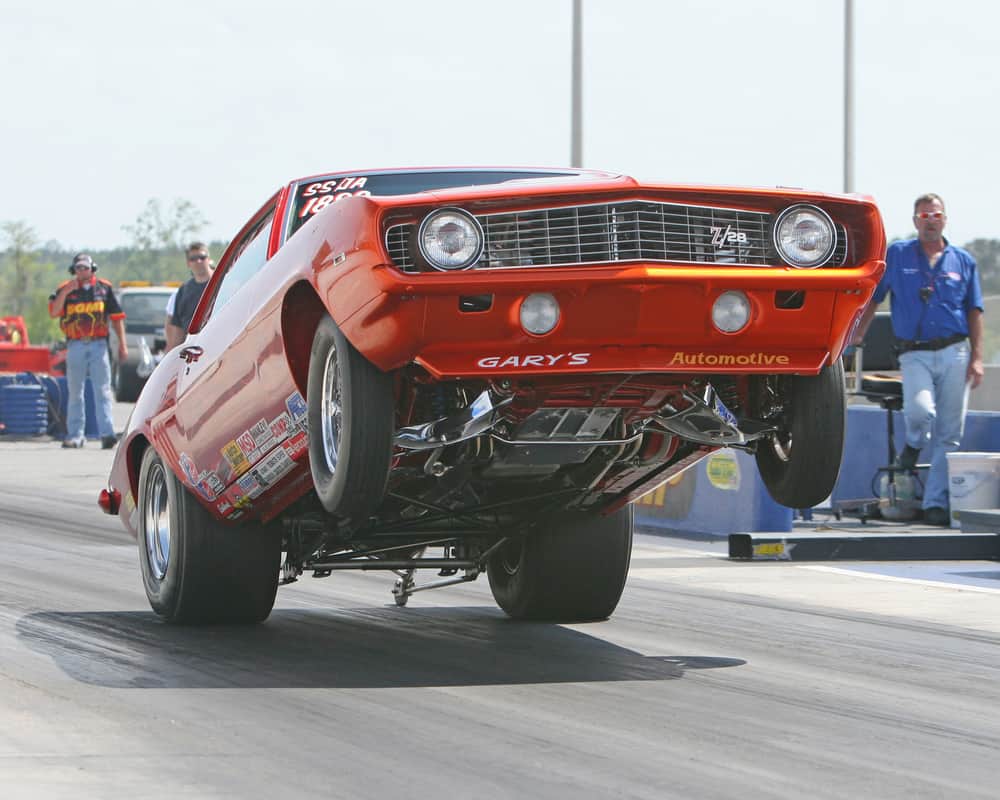
Drag Racing Legally – What To Expect Step By Step
To start the journey to drag race legally, you will need to comply with several regulations. Firstly, seek out an NHRA Member Track that hosts NHRA Street Legal Style Drag Races. You will be required to pay your entry fee, determined per track, on the day, and you will receive a Tech Card.
You need to fill out all the required information on the Tech Card, and then you take your vehicle and present it at the tech area for the safety inspection. The staff in the tech area will thoroughly check your vehicle to ensure it meets the regulations. This is;
- Working Seat Belts and clips.
- Working standard colored headlights and taillights and brake lights.
- DOT-Approved Drag Racing tires with sufficient tread.
- A properly secured battery
- Clothing – Cotton only long pants, long-sleeved cotton shirt. Standard socks and closed-toe shoes. This is your required outfit to be allowed to make a run.
- A regulation helmet with a full visor depending on the car class you participate in.
If you are unsure of the track in your area’s regulations, please contact them beforehand. The NHRA track staff will gladly assist you in getting your drag racing car in order to meet the rules and specifications.
What Do I Need To Participate In A Street Style Drag Race?
Each state might have different regulations, so the best advice would be to contact the NHRA member track near you, confirm the division you are planning on participating in, and get the required list from them. You can expect to need proof of the minimum following;
- A driver’s license valid in your state.
- Vehicle registration and insurance papers that are up to date.
- DOT-approved Street Drag Racing tires.
- Working seat belts and clips.
- A muffler
- Nitrous-Oxide users must ensure the bottles are stamped that it meets the required DOT- 1800-pound standard.
At The Track – What To Expect Step By Step
The following steps are standard at any NHRA track. When you plan to enter in a Street Legal Drag Race, you should make yourself familiar with the track flow as follows;
- Paying The Entry Fee – Before you can participate, you will need to pay the entry fee.
- Tech Card – As you enter the NHRA track, you will receive a Tech Card you need to complete
- Tech Area Inspection – Upon completion of your Tech Card, you proceed to the Tech Area. Here the Tech Crew will do a full inspection of your vehicle to check that it adheres to safety regulations.
- Driver Registration – After the Tech Inspection, you proceed to the Driver Registration. Here you will sign an indemnity/release form, and you will be required to produce your driver’s license.
- The Staging Lanes – After you signed the release form, you need to drive to the rear area of the staging lanes. You are now getting ready to race.
- The Race – When you are next in line to race, the lane official will motion you to come closer and get ready. As you get ready to stage, you might be allowed to do a burnout of the official permits. When both cars are ready, The Tree will start the lighting sequence to set you off. Once you pass the finish line, you need to slow down and exit the strip slowly.
- The Timing Booth – After your run, you drive to the timing booth, where the official will hand you your timing slip. This slip will indicate your eighth-mile and quarter-mile times. You can proceed back to the pits for a check-up and then do another run.
Dragstrip Etiquette
Like with any sport, drag racing also has a set number of rules and etiquette. This is important to know, especially at the staging lanes, so that you don’t cause a delay or get disqualified. Here is what you need to know;
Staging Lanes
1. Always ensure you are in the correct staging lane. Also, check that you are running in a suitable vehicle class. If you are unsure of anything, never hesitate to ask the official.
2. Never pass another car in front of you while waiting in the staging lane unless the official motions you to do so.
Burnouts
1. Never start a burnout unless the official indicates that you can. There is usually a hand signal. Always ensure you are entirely on the track and that your tires are facing forward.
2. If you do not have slicks, refrain from doing burnouts with your treaded tires in water. The water gets trapped in the tire tread areas, and you spill water all the way down the strip and slow you down a bit. This infuriates the drag racers with slicks. Don’t do burnouts in the water with treaded street tires.
3. Please do not do a John Force-style burnout; that is when you spin the tires through and over the starting line unless you are John Force.
Courtesy Staging
Some tracks employ a Courtesy Staging Rule. Check this rule on the track that you plan to race on. What is the Courtesy Staging Rule?
- The first car into the staging beams lights only the pre-stage light.
- After the second car has pre-staged, either vehicle can then move up to the lights.
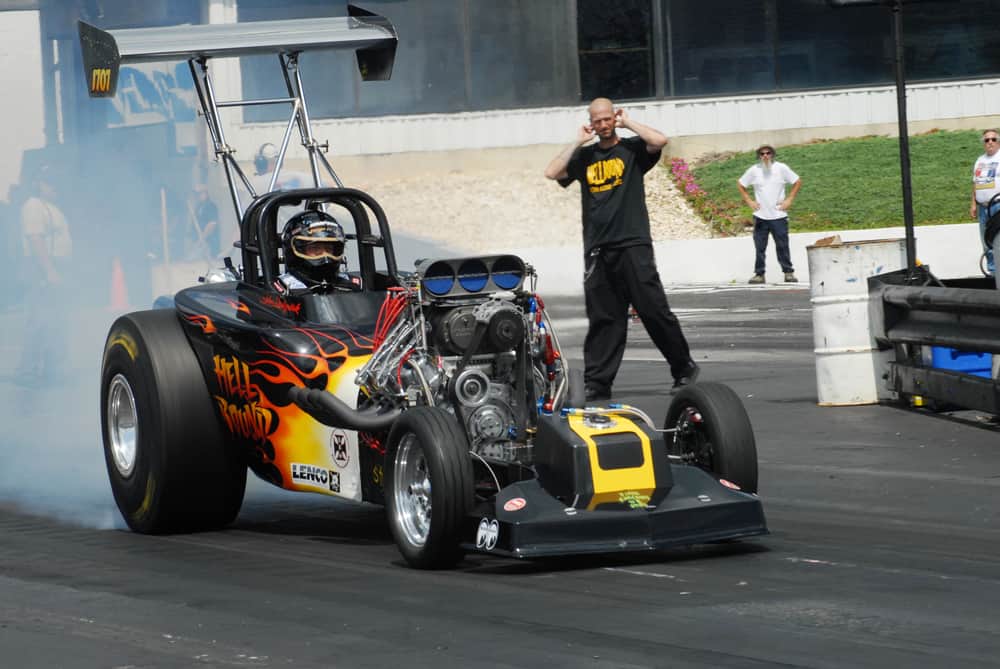
The NHRA Rules For Street Style Drag Racing
In order to drag race safely, successfully, and all the while having fun, it is essential to acquaint yourself with the NHRA rules for safety and the basic requirements for your class vehicle. Here are several vital snippets from the NHRA rulebook.
Street Cars
Below is a list of general rules for the different Street Style Drag Racing car classes. Some regulations cover all vehicles like license, safety, and tires;
- 13.99-second cars.
- Slicks tires and a Driveshaft Safety Loop.
- NHRA approved helmet with a full face cover in open cars.
- The jacket needs to be an SFI 3.2A/1 in all cars fitted with non-OEM Nitrous-oxide, super or turbocharged.
- 13.49-second cars
- Convertibles are required to fit a rollbar.
- Convertibles are required to fit SFI seat belts.
- 11.99-second cars
- Steel valve stems for durability.
- Arm restraints on open cars.
- 11.49-second cars
- Needs an SFI 1.1 or 1.2 flywheel or clutch.
- Needs an SFI 6.1 / 6.2 / 6.3 or a 9.1 flywheel shield.
- Driver required to wear an SFI 3.2A/1 approved jacket.
- The car fitted with a 6-point roll bar.
- The driver needs SFI approved seat belts.
- 10.99 seconds or Super Streetcars
- Needs an SFI 4.1 transmission shield.
- Fitted with a locking transmission dipstick tube.
- Upgraded aftermarket axles and axle retainers.
- Fitted with an SFI harmonic balancer.
- A full roll cage. Altered floor pans.
- Window net required @ 135mph.
- 9.99 second or Super Gas or 135 mph cars
- NHRA approved chassis certification.
- A valid NHRA competition license.
- Diver required to wear an SFI jacket and pants 3.2A/5.
- An SFI neck collar and gloves 3.3/1.
- A SFI 29.1 flex-plate / 30.1 flex-plate shield for AT equipped cars.
- Driver to wear a full-face helmet meeting Snell or SFI specs.
Auto Trans Reverse Lockout
- All non-OEM floor-mounted automatic transmission shifter must have the following – A spring-loaded positive reverse gear lockout. The lockout is to prevent the shifter from being put into reverse gear accidentally.
- A neutral safety switch is a requirement.
Roll Bars
- All convertibles faster than 8.25sec are required to have 6-point roll bars fitted.
- Mandatory roll bars are required on all cars quicker than 7.35 sec.
Roll Cages
- Convertibles running 6.99sec or faster than 135mph require roll cages.
- All cars running 6.99sec or faster than 135mph require roll cages.
- All cars running 6.39 Elapsed Time and quicker are required to possess an NHRA Competition License. The vehicle must have a valid NHRA Chassis Certification.
Helmets
- All drivers of 8.59 or quicker cars, including motorcycles, must wear a helmet that meets Snell or SFI Specifications.
- Mandatory for drivers to wear a full-face helmet on all cars 9.99 (1/4 mile)/6.39 (1/8 mile) or faster.
- A shield is mandatory for 7.49 sec (1/4 mile) and quicker.
Nitrous Oxide
- Nitrous oxide that is commercially available is permitted.
- A Nitrous-oxide bottle that is in the driver compartment has to be fitted with a relief valve. Bottles outside of the compartment have to be vented.
- All nitrous-oxide bottles have to be stamped with a DOT-1800-pound rating. Bottles need to be permanently mounted.
- The hoses that run from the solenoid to the bottles must be NHRA approved, steel-braided high-pressure hoses.
- Only commercially available blanket-type warmers that are thermostatically controlled are permitted. External heating of the bottles is prohibited.
Liquid Overflow
- All vehicles must have a liquid recovery system, or a catch can be fitted for the radiator with a minimum capacity of 16 oz.
Driveshaft loop
- For universal joint driveshafts cars: A front driveshaft loop is required on all vehicles running at 11.49 or slower and is equipped with street tires.
Battery Relocation
- Batteries that are not fitted in the traditional position in the engine but the trunk: An external cut-off switch is required that also cuts the engine.
Seat Belts
- All vehicles must be fitted with an approved quick-release drivers’ seat belt.
- All vehicles in a competition that requires a roll cage or roll bars need to be fitted with a DRS or Driver Restraint System.
Driver Restraint Systems
- A mandatory requirement is a quick-release, 3-inch shoulder harness with SFI Spec 16.1 with a crotch strap in all cars that need roll cages or roll bars.
- The SFI 16.1 manufacturers’ spec must be dated and visible on the driver restraint system.
- The driver restraint system needs to be updated every two years.
- The restraint system must be from the same original manufacturer and cannot be matched with parts from a different supplier.
- Vehicles that use OEM seating can run the crotch strap in front of the seat instead of through.
- Only simultaneous 5-point release drivers restraint systems will be permitted.
- Bolts inserted through the belt webbing for the mounting are strictly prohibited.
Wheels & Lug Nuts
- All-wheel lugs and nuts must be fitted and securely tightened.
- Street tires are required to have a 1/16-inch tread depth available.
- Cars that run with slicks must be fitted with open-ended lug nuts.
- The overall length of the stud/bolt does not determine that it will be permitted.
Does Insurance Cover Drag Racing?
This is the one reasonably controversial area. Most standard home or automotive insurance companies will not cover racing any liabilities arising from it through their policies.
Their policy wording commonly excludes all types of racing, be it amateur racing, motocross, drag racing, or professional F1. The NHRA has general liability insurance covering the drivers on the tracks for specific events provided all safety criteria were met.
Conclusion
Drag racing can be enjoyed by anyone with a passion, the right vehicle, and some spare money to spend on the required safety features and personal protection. One of the most significant expenses will be buying an excellent set of Street Legal Drag Racing tires. This aspect is vital to keep your car gripping the asphalt.
Drag racing on government property is not only illegal, but it is also dangerous. Many people like to watch racing, and in an illegal racing situation, people can and do get hurt. The correct and fun way to drag race legally is to make an effort and adhere to the NHRA rules, find a track, pay your fee, and put your foot on the gas down the strip.
Sources
https://www.nhra.com/nhra-drags-street-legal-style/street-legal-style
https://www.nhra.com/news/2020/2021-nhra-rulebooks-now-available-online


